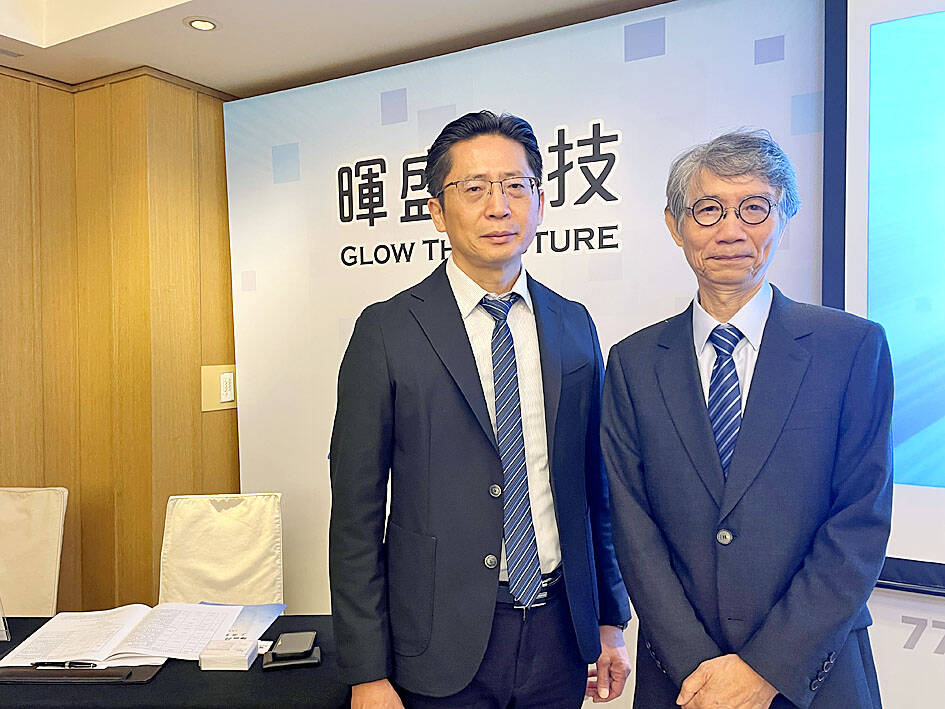Plasma-based equipment supplier Nano Electronics and Micro System Technologies Inc (暉盛科技) yesterday forecast revenue this year would continue to slip before surging back next year on the back of robust demand for IC substrates for artificial intelligence (AI) applications, and increasing adoption of new glass core substrates and wafer panel-level packaging technology.
The Tainan-based company attributed a slump in its revenue to IC substrate inventory correction over the past two years.
During the first eight months of this year, revenue dropped 7.28 percent to NT$299 million (US$9.8 million), from NT$323 million a year earlier.

Photo: CNA
The company makes a wide range of equipment for plasma etching, substrate plasma cleaning, de-bond plasma cleaning and wafer plasma etching. The equipment is used by semiconductor, IC substrate and printed circuit board (PCB) makers. Wafer makers, wafer reclaim companies and chip packagers are also among its customers.
“Plasma technology is the core competence of our company. We believe the gold age of plasma is coming,” Nano Electronics chairman Sung Chun-yi (宋俊毅) told a news conference in Taipei.
As OpenAI drives explosive growth for hardware, powered by AI chips, it is critical to raise the yield rate in semiconductor manufacturing, given its high price tag, Sung said.
The company’s plasma equipment could play a key role in improving yield rate, he said.
The company expects the semiconductor segment to become its biggest revenue contributor, making up 46 percent of total revenue next year, up from 17.7 percent this year. The IC substrate segment would fall to the second-largest contributor, accounting for up to 29.4 percent, down from 43.43 percent this year.
“The company’s order visibility is more than six months and could extend to one year,” company spokesman Kelvin Chiu (邱冠陸) said. “In addition, we recently received rush orders from customers from the AI server supply chain, which would help boost revenue growth momentum.”
Next year, the company is looking at new revenue growth from glass core substrate and wafer manufacturing customers as glass core technology is adopted by the whole semiconductor supply chain in preparation for volume production in 2027 or at the beginning of 2028, Chiu said.
It takes up to six months for the company to ship its equipment, he said.
“We are expecting significant growth next year,” he added.
The company counts Taiwan Semiconductor Manufacturing Co (台積電), the world’s biggest contract chipmaker; ASE Technology Holding Co (日月光投控), the world’s biggest chip packager; and PCB suppliers Zhen Ding Technology Holding Ltd (臻鼎) and Unimicron Technology Corp (欣興電子) among its customers.
The company is scheduled to trade its shares on the Taiwan Stock Exchange’s Taiwan Innovation Board next month, becoming the second firm to list on the board this year.
In the first half of this year, the company reported NT$15.15 million in net profit, plunging 62 percent from NT$39.39 million a year earlier, while earnings per share dropped to NT$0.44 from NT$1.14.

The DBS Foundation yesterday announced the launch of two flagship programs, “Silver Motion” and “Happier Caregiver, Healthier Seniors,” in partnership with CCILU Ltd, Hondao Senior Citizens’ Welfare Foundation and the Garden of Hope Foundation to help Taiwan face the challenges of a rapidly aging population. The foundation said it would invest S$4.91 million (US$3.8 million) over three years to foster inclusion and resilience in an aging society. “Aging may bring challenges, but it also brings opportunities. With many Asian markets rapidly becoming super-aged, the DBS Foundation is working with a regional ecosystem of like-minded partners across the private, public and people sectors

Taiwan Semiconductor Manufacturing Co (TSMC, 台積電) has secured three construction permits for its plan to build a state-of-the-art A14 wafer fab in Taichung, and is likely to start construction soon, the Central Taiwan Science Park Bureau said yesterday. Speaking with CNA, Wang Chun-chieh (王俊傑), deputy director general of the science park bureau, said the world’s largest contract chipmaker has received three construction permits — one to build a fab to roll out sophisticated chips, another to build a central utility plant to provide water and electricity for the facility and the other to build three office buildings. With the three permits, TSMC

BREAKTHROUGH TECH: Powertech expects its fan-out PLP system to become mainstream, saying it can offer three-times greater production throughput Chip packaging service provider Powertech Technology Inc (力成科技) plans to more than double its capital expenditures next year to more than NT$40 billion (US$1.31 billion) as demand for its new panel-level packaging (PLP) technology, primarily used in chips for artificial intelligence (AI) applications, has greatly exceeded what it can supply. A significant portion of the budget, about US$1 billion, would be earmarked for fan-out PLP technology, Powertech told investors yesterday. Its heavy investment in fan-out PLP technology over the past 10 years is expected to bear fruit in 2027 after the technology enters volume production, it said, adding that the tech would

RUN IT BACK: A succesful first project working with hyperscalers to design chips encouraged MediaTek to start a second project, aiming to hit stride in 2028 MediaTek Inc (聯發科), the world’s biggest smartphone chip supplier, yesterday said it is engaging a second hyperscaler to help design artificial intelligence (AI) accelerators used in data centers following a similar project expected to generate revenue streams soon. The first AI accelerator project is to bring in US$1 billion revenue next year and several billion US dollars more in 2027, MediaTek chief executive officer Rick Tsai (蔡力行) told a virtual investor conference yesterday. The second AI accelerator project is expected to contribute to revenue beginning in 2028, Tsai said. MediaTek yesterday raised its revenue forecast for the global AI accelerator used